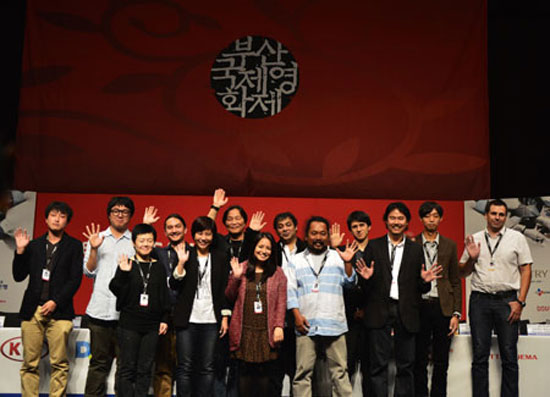- California Assembly OKs highest minimum wage in nation
- S. Korea unveils first graphic cigarette warnings
- US joins with South Korea, Japan in bid to deter North Korea
- LPGA golfer Chun In-gee finally back in action
- S. Korea won’t be top seed in final World Cup qualification round
- US men’s soccer misses 2nd straight Olympics
- US back on track in qualifying with 4-0 win over Guatemala
- High-intensity workout injuries spawn cottage industry
- CDC expands range of Zika mosquitoes into parts of Northeast
- Who knew? ‘The Walking Dead’ is helping families connect
Asian directors portray shifting societies

A group of Asian directors, whose works were featured in the “New Currents” section of the Busan International Film Festival, pose for the cameras at the
Centum City in Busan, Monday. / Korea Times photo by Yun Suh-young
By Yun Suh-young
BUSAN — The Busan International Film Festival (BIFF) is first and foremost a celebration of Asian film. This has never been more apparent than this year’s event, which features dozens of works in different genres that seem to qualify as authentic representations of the filmmaker’s cultural and social backgrounds.
The film festival’s “New Currents” section, aimed at identifying new talent and exposing the cinematic works from countries with lesser-known movie making sectors, is a must-see for this reason.
The 13 directors whose works were featured in the New Currents section held a news conference on Monday. They were in agreement that culture and social issues were an essential part of their films, whether it be “road movies” or coming-of-age stories.
“‘Isthmus’ is a reflection of the Asian region as a whole which has differences of religion, beliefs and culture. We tried to focus on the notion of home — the mobility of the people,” said Sopawan Boonimitra, a Thai director who co-directed “Isthmus” with Peerachai Kerdsint. Isthmus is about a young girl who loses the ability to speak in her native Thai when a Myanmar-born maid who took care of her dies.
Mongolian director Byamba Sakhya said his film “Remote Control” was about using cultural elements for social commentary. The movie portrays a young man who becomes attracted to a young girl living in an apartment building across the street from his. He starts to secretly interfere with her television reception, but finds himself with a growing desire to control every aspect of her life.
“It’s not only a film about coming of age. It’s about society in transition. The movie reflects what Mongolia still looks like — facing many unknown things. Our system is changing and it’s quite challenging but still hopeful,” said Sakhya.
Another Thai director, Lee Chatametikool of “Concrete Clouds,” said he was inspired by the ongoing influence of the Asian financial crisis, which intensified the social problems related to inequality.
“The background of the movie is Thailand during the financial crisis which Korea has also gone through. In that sense, the movie is like a tribute to a shared history between the two countries,” said Chatametikool.
“It’s about the gap between past and present, dreams and reality. I wanted to make a film about the monuments — of youth, of time, of love — of which we could no longer retain or go back to.”
The movie is about a 30-year-old currency trader who returns to his home country Thailand after his father commits suicide at the onset of the 1997 financial meltdown. He finds himself struggling to adapt to a culture and social atmosphere he can no longer identify with.
Concrete Clouds was just one of many movies dealing with the problems of economic problems and the decay of societies.
Kanai Junichi who directed “Again” said he was inspired by a unique program in Japan where the victims of crimes get to meet their perpetrators face-to-face for a talk.
“I decided to make a movie after finding out about this program. It made me think, ‘Is it possible to resolve everything by law? Couldn’t the victim and the perpetrator find a solution through conversation and find hope?’ I found drama in this situation where I witnessed the conversation and it made me want to transfer it on screen,” said Junichi.
“But for teenage crimes, the government still makes the decision for them. The core theme of this movie is that people can hurt each other but also save each other.”
For Indian director Girish Malik of “Jal,” which means water in Hindi, bare-naked human nature is found in the way they deal with environment issues. The movie is about an Indian man who helps a group of European bird researchers build a well, only to end up disrupting the order of his community with misjudgment and greed.
“A large part of the population is still dealing with issues over water. We all need water. But the question arises: Whose life is more important? Humans? Animals? Or nature? I wanted to depict the greed and jealousy of people in desperation for water,” said Malik.
Hannah Espia’s “Transit” is a film about the identity crises of migrant workers.
The struggle begins when Filipino workers who live in Tel Aviv are told by the Israeli government that children of migrant workers will be deported back to their country.
“I was inspired by a personal encounter with a Filipino migrant worker I met at the airport who had to take home his child due to the government declaration. These children, who had no love for their culture, were being deported to somewhere they didn’t know,” said Espia.
“I wanted tell a story about children who are born and raised in a foreign land who go through an identity crisis of whether they are Israeli or Filipino.”
A Korean film, “10 Minutes” by director Lee Yong-seung is a unique story about a contract worker who receives an offer to become a regular employee. The unemployment issue and the difficulty of getting a job are touched upon in a painfully realistic but comic way.
“I wanted to realistically depict the youth unemployment issue and the loss of their dreams in detail and share it with the audience,” said Lee.
Kim Ji-seok, executive programmer at BIFF, said the films “reflect that the Asian region is more dynamic than any other region in the world.”
“We invited a variety of films from different genres. The films are experimental and very dynamic — the themes range from Diaspora to coming of age. I am positive these directors will lead the future of Asian film,” said Kim.















